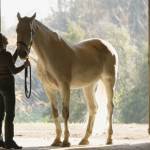Choosing a Riding Instructor for Beginners

Maybe your child read a book about horses, watched a movie starring a pony, or saw a calf-roping demonstration at the county fair. Regardless of what sparked the interest, many parents eventually field the question: “Mom, can I take riding lessons?” At some point, if you have enough time and money (will probably require more money than you expected!), you will find yourself looking for a suitable riding instructor.
Spending some time in finding the right instructor is important for your child’s safety. It may be hard to distinguish good lessons, horses, and instructors from bad, especially if you are not familiar with riding and horses. However, this is a vital first step that should not be taken lightly.
An Internet search may turn up the names of some instructors and lesson barns in your area. Other places to ask about riding lessons are feed stores, tack shops, and your local agricultural extension office. If you attend a horse show featuring the style of riding your child is interested in, ask some of the riders (or their parents) who their coaches are and where they go for lessons or instruction. Don’t bother them as they are waiting to go into the ring for their classes; wait to talk to them until they are finished showing and are back at their stalls or trailers.
When you have a list of several instructor prospects, call them and ask if they accept students of your child’s age for lessons. Keep in mind that many children under the age of eight or so have short attention spans and may not have the strength, size, or physical conditioning to benefit from a lesson lasting 45 to 60 minutes, so don’t be surprised if there is an age requirement. If the instructor will accept your child, ask what kind of riding is offered. Your child may want to learn to jump, or herd cattle from horseback, or ride a gaited show horse. Mention these goals to the instructor, as each of these interests will call for different horses, riding styles, and instructors.
When you find an instructor that might be a match, arrange to go with your child to watch a lesson or two. Seeing the horses, facilities, and teaching method will tell you a lot. Are the horses clean, shiny, and at a good weight, or are they muddy, dull-coated, and thin, with ribs easily visible? Do the horses seem exceptionally nervous, jumpy, tired, or lame? Are the saddles, bridles, and other equipment clean and in good condition? Are the barns and stalls clean, dry, and well lighted? Are the riding rings or arenas fenced so horses can’t wander off in the middle of a lesson? Are the fences and gates safe and in good repair, even if they are not fancy? Is someone supervising children at all times, or are the children allowed to wander around the barns and horses without an adult in charge? Are the students required to wear protective helmets when they are mounted?
As the instructor teaches a class, pay attention to how she relates to the students. Is she helpful and encouraging, or sarcastic and angry? Is she offering suggestions and explaining what she is asking for, or does she just stand in the center of the ring without actually teaching very much? Is she paying attention to the students, or talking on a cell phone, chatting with parents, chasing dogs out of the ring, or dealing with her own small children?
When you find an instructor who seems like a good fit for your child, it’s time to sign up your child for lessons. At this point, you need to be realistic about goals. In a children’s riding lesson, don’t be surprised if it seems there isn’t a lot of obvious progression. Keep in mind that a lot of what a child learns is simply being comfortable on the horse. For a youngster of seven or eight, just staying in the correct position in the saddle and keeping the horse moving in the right direction may be a lot to think about. Learning balance, building muscle strength, and remembering to guide the horse must be accomplished before the child moves on to faster gaits and more advanced skills. Though the instructor may want to start with a few private lessons, riding in a small group setting might be the best way for your child to learn and practice the basics of riding.
There are no national standards for riding instructor certification, though such programs exist on some level for certain disciplines. Credentialing may not be important depending on a student’s skill level and interest, and certification brings no guarantee that a particular instructor will be a good fit for your child.
If your child enjoys the lessons and wants to keep going after a few months, ask about other activities. Does this instructor have her students enter shows or competitions? Are there any enrichment opportunities like lectures, summer horse camp, Pony Club, or contact with more advanced riders? Will there be opportunities to ride different horses in the future? The instructor should be willing to discuss the child’s current progress and future goals.
Finally, don’t be in too much of a hurry to buy your child a horse of his own. Owning a horse is much more complicated and expensive than taking riding lessons on someone else’s horse. When you do make the decision to become a horse owner, ask the instructor what sort of horse would be most suitable for your child, and take an experienced rider along when you go to look at and try out that first horse. Pay particular heed to two time-honored bits of horse-trading advice: “Don’t buy the first horse you try” and “Don’t buy someone else’s problems.” Add the age of your child to the age of the prospective purchase; human and first-horse years should total at least 20, and preferably 25.








